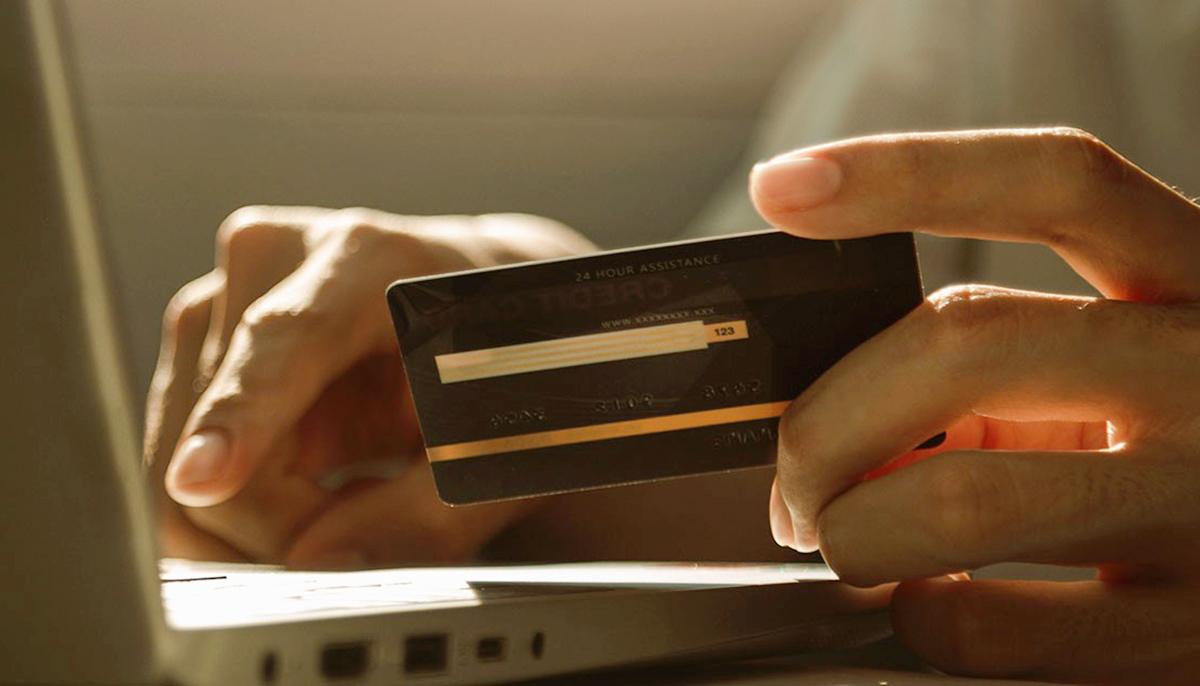

Finance
How To Co Sign A Credit Card
Published: November 7, 2023
Learn how to co-sign a credit card and navigate the world of finance with ease. Gain valuable insight and tips to ensure a smooth co-signing process.
(Many of the links in this article redirect to a specific reviewed product. Your purchase of these products through affiliate links helps to generate commission for LiveWell, at no extra cost. Learn more)
Table of Contents
Introduction
In today’s world, having a good credit score is essential for various financial activities, including applying for loans or renting an apartment. However, not everyone has a strong credit history, especially young adults or individuals who are new to the credit system. This is where co-signing a credit card can be a helpful solution.
Co-signing a credit card involves having a trusted individual agree to take on joint responsibility for the credit card with the primary cardholder. The co-signer’s credit history is taken into account by the credit card issuer, allowing the primary cardholder to have access to a credit line they may not qualify for independently.
While co-signing a credit card can provide an opportunity for individuals to build their credit and access financial resources, it’s essential to understand the benefits and risks involved. This article will guide you through the process of co-signing a credit card, highlighting important factors to consider and steps to protect yourself as a co-signer.
By the end of this article, you will have a comprehensive understanding of how co-signing a credit card works and the importance of making informed decisions when considering this option.
Understanding Co-Signing a Credit Card
Co-signing a credit card involves one person, known as the co-signer, agreeing to take equal responsibility for the credit card alongside the primary cardholder. The primary cardholder is typically someone with a limited credit history or a lower credit score, who may struggle to qualify for a credit card on their own.
When a credit card is co-signed, both the primary cardholder and the co-signer are equally liable for any debts or payments associated with the card. This means that if the primary cardholder fails to make payments or defaults on the card, the co-signer is legally obligated to cover the outstanding balance.
It’s important to recognize that co-signing a credit card is a significant commitment. It is not a casual agreement or merely offering assistance; it involves a legal and financial partnership that can have long-term implications. Both parties need to fully understand the implications and responsibilities before entering into a co-signing arrangement.
From the perspective of the credit card issuer, co-signing provides added security. The presence of a co-signer with a strong credit history reassures the credit card issuer that if the primary cardholder is unable to make payments, there is someone qualified to take over the responsibility of the debt. This increased security allows the primary cardholder to access credit that they may not otherwise be eligible for.
For the primary cardholder, co-signing provides an opportunity to build or repair their credit history. By using the credit card responsibly and making timely payments, they can demonstrate their creditworthiness and improve their credit score over time. Additionally, having a credit card can be beneficial for everyday transactions, travel, emergencies, and building financial independence.
Benefits and Risks of Co-Signing a Credit Card
Co-signing a credit card can have both positive and negative consequences. Understanding the benefits and risks associated with this financial arrangement is crucial before deciding to co-sign. Let’s explore them in more detail.
Benefits
1. Build Credit: Co-signing provides an opportunity for the primary cardholder to build or establish their credit history. Responsible use of the credit card, such as making timely payments and keeping credit utilization low, can contribute to a positive credit score.
2. Access to Credit: Co-signing allows an individual with a limited credit history or lower credit score to access credit that they might not otherwise qualify for independently. This can be especially helpful for young adults or individuals who are new to the credit system.
3. Financial Independence: Having their own credit card can help the primary cardholder become more financially independent. They can manage their expenses, make online purchases, and handle emergencies without relying solely on their co-signer.
Risks
1. Financial Liability: Co-signing means assuming equal responsibility for the credit card debt. If the primary cardholder defaults or fails to make payments, the co-signer becomes legally obligated to repay the debt. This can negatively impact the co-signer’s credit score and personal finances.
2. Credit Score Impact: Any missed payments or high credit utilization by the primary cardholder can affect both their and the co-signer’s credit scores. It is essential for both parties to communicate and ensure responsible credit card usage to avoid any negative impact.
3. Strained Relationships: Co-signing can strain relationships, especially if there are issues with repayment or disputes about how the credit card is used. It is crucial to have open and honest communication to prevent potential conflicts that may arise.
4. Limited Control: As a co-signer, you won’t have direct control over how the credit card is used. It is essential to trust and have confidence in the primary cardholder’s ability to manage their finances responsibly.
Considering the benefits and risks is crucial before making the decision to co-sign a credit card. It is recommended to thoroughly discuss expectations and responsibilities with the primary cardholder and evaluate your own financial situation and risk tolerance.
Essential Factors to Consider Before Co-Signing
Before deciding to co-sign a credit card, it’s essential to thoroughly consider certain factors that can have long-term implications for both parties involved. By evaluating these factors, you can make an informed decision that aligns with your financial goals and circumstances. Here are some key considerations:
1. Trust and Relationship
Co-signing is a significant financial commitment that requires a high level of trust in the primary cardholder. Consider your relationship with the person you are co-signing for and assess their level of responsibility and financial stability. Open and honest communication is crucial in building and maintaining trust throughout the co-signing arrangement.
2. Financial Capability
Assess your own financial capability to cover the credit card debt if the primary cardholder defaults or fails to make payments. Consider your income, expenses, and any other financial obligations you may have. Ensure that you have sufficient resources to handle the potential financial liability associated with co-signing.
3. Credit Score Impact
Understand that your credit score may be affected by the co-signed credit card. Late payments, high credit utilization, or default on the credit card by the primary cardholder will also reflect on your credit history. Evaluate the potential impact on your credit score and how it may affect future borrowing opportunities.
4. Long-Term Commitment
Co-signing is a long-term commitment, as credit card debts may take time to repay. Consider your readiness for a potentially extended financial responsibility and any potential changes in your circumstances that may occur during this period.
5. Exit Strategy
Discuss and establish an exit strategy with the primary cardholder. Determine how and when the co-signing arrangement will be dissolved. This may include the primary cardholder becoming eligible for an individual credit card or refinancing the credit card debt without the need for a co-signer.
6. Alternative Options
Explore alternative options for the primary cardholder to build credit. There may be other ways, such as becoming an authorized user on an existing credit card or applying for a secured credit card, that can help them establish credit without the need for a co-signer.
Considering these essential factors will empower you to make a well-informed decision about co-signing a credit card. It’s important to weigh the pros and cons, assess your financial capacity, and communicate openly with the primary cardholder to ensure a successful co-signing arrangement.
How to Co-Sign a Credit Card
If you decide to proceed with co-signing a credit card, it’s important to follow a step-by-step process to ensure a smooth and successful co-signing arrangement. Here are the steps to co-sign a credit card:
1. Research Credit Card Options
Research credit card options that are suitable for co-signing. Look for credit cards that offer benefits and features that align with the primary cardholder’s needs. Compare interest rates, annual fees, rewards programs, and credit limits to find the best fit.
2. Communicate with the Primary Cardholder
Have an open and honest conversation with the primary cardholder. Discuss their financial goals, spending habits, and responsibilities. Ensure that both parties have a clear understanding of the expectations and terms of the co-signing arrangement.
3. Gather Necessary Documentation
Collect all the necessary documentation required by the credit card issuer. This typically includes identification documents, proof of income or employment, and personal information for both the primary cardholder and the co-signer.
4. Apply for the Credit Card
Complete the credit card application process with the primary cardholder. Provide accurate information and review the application thoroughly before submitting it. Make sure to include the co-signer’s information as required.
5. Wait for Approval
Once the application is submitted, you will need to wait for the credit card issuer to review and approve it. The approval process can vary in duration, but you will receive a notification once the decision has been made.
6. Receive and Activate the Credit Card
If the application is approved, the credit card will be mailed to the primary cardholder’s address. Once received, follow the instructions provided to activate the credit card, either through an online portal or phone call.
7. Set Usage and Payment Guidelines
Establish clear guidelines for the usage and payments of the credit card. Discuss the primary cardholder’s spending limits, payment due dates, and responsible credit card management. This will help ensure that both parties are on the same page regarding the responsible usage of the credit card.
8. Regularly Monitor the Credit Card Account
As a co-signer, it’s important to monitor the credit card account regularly. Keep track of transactions, payment due dates, and any potential issues or discrepancies. This will help you stay informed and address any concerns promptly.
Remember, open communication, trust, and responsible financial management are key to a successful co-signing arrangement. Regularly review the credit card statement and check in with the primary cardholder to ensure that they are using the credit card responsibly and making payments on time.
Steps to Protect Yourself as a Co-Signer
Co-signing a credit card comes with financial obligations and potential risks. To protect yourself as a co-signer and mitigate any negative consequences, it’s crucial to take certain steps and establish safeguards. Here are some key measures to consider:
1. Maintain Open Communication
Ensure that you maintain open and transparent communication with the primary cardholder. Regularly discuss credit card usage, balances, and payment schedules. This will help prevent any surprises and allow you to address any issues promptly.
2. Set Spending Limits
Establish clear spending limits with the primary cardholder. Determine a maximum amount that can be charged on the credit card to avoid excessive debt. Make sure both parties understand and agree to these limits to prevent overspending.
3. Monitor Credit Card Activity
Regularly monitor the credit card activity and review the monthly statements. Keep an eye out for any unauthorized charges or suspicious transactions. If you notice anything concerning, address it immediately with the primary cardholder and the card issuer.
4. Regularly Check Credit Reports
Periodically review your credit reports to ensure that the co-signed credit card is being managed responsibly. Look for any late payments or negative marks on your credit history. If there are any discrepancies, report them to the credit bureau and work to resolve the issue.
5. Have an Emergency Fund
Build and maintain an emergency fund to protect yourself from any unexpected financial burdens. Having a safety net will give you peace of mind, knowing that you have resources to cover any potential credit card debt if the primary cardholder is unable to make payments.
6. Stay Informed on Legal Rights and Responsibilities
Understand your legal rights and responsibilities as a co-signer. Educate yourself on the terms and conditions of the credit card agreement, including your liability for the debt. Knowing your rights can help you navigate any issues that may arise during the co-signing arrangement.
7. Have an Exit Strategy
Discuss and establish an exit strategy with the primary cardholder. Plan and set goals to transition the credit card into the primary cardholder’s name alone. This may involve the primary cardholder building their credit and qualifying for an individual credit card or refinancing the debt to remove your responsibility as a co-signer.
Taking these steps will help protect yourself as a co-signer and reduce the potential risks associated with co-signing a credit card. Remember, being proactive and vigilant is key to ensuring a positive co-signing experience.
Co-Signing Alternatives to Consider
While co-signing a credit card can provide individuals with an opportunity to build credit and access financial resources, it is not the only option available. If you are hesitant about co-signing or want to explore alternative pathways, here are some alternatives to consider:
1. Authorized User
Instead of co-signing, you can consider adding the individual as an authorized user on your existing credit card. This allows them to use the card, but as the primary account holder, you maintain control over the account and are responsible for the payments. This option allows the individual to build credit history while limiting your financial liability.
2. Secured Credit Card
A secured credit card is another alternative for individuals with limited credit history or lower credit scores. With a secured credit card, the individual provides a deposit as collateral, which then becomes their credit limit. It’s an effective way to establish credit without the need for a co-signer, as the credit card is backed by the deposit.
3. Credit Builder Loans
Credit builder loans are specifically designed to help individuals establish or improve their credit score. With a credit builder loan, the individual borrows a small sum of money and makes regular payments over a specific period. Once the loan is repaid, they have a positive payment history, contributing to a stronger credit profile.
4. Financial Education and Guidance
Encourage the individual to seek financial education and guidance to better understand credit and how to improve their creditworthiness. Many organizations and financial institutions offer free resources, workshops, and counseling services to help individuals navigate the credit system and improve their financial health.
5. Delay the Credit Card Application
If the primary cardholder is not in immediate need of a credit card, you may consider delaying the application and working on improving their credit score first. This could involve paying bills on time, managing existing debts, and reducing credit utilization. By taking these steps, they may eventually become eligible for an individual credit card without the need for a co-signer.
It’s important to evaluate these alternatives based on the individual’s unique circumstances and financial goals. Discuss the options together and weigh the pros and cons of each before making a decision. Remember, the goal is to help the individual build credit responsibly and achieve financial independence.
Frequently Asked Questions (FAQs)
1. What are the risks of co-signing a credit card?
Co-signing a credit card carries financial risks. If the primary cardholder fails to make payments or defaults on the card, the co-signer becomes responsible for the debt. This can have a negative impact on the co-signer’s credit score and personal finances.
2. Can co-signing a credit card help build credit?
Yes, co-signing a credit card can help the primary cardholder build credit. By using the credit card responsibly and making timely payments, the primary cardholder can establish a positive credit history. However, any negative credit card activity, such as late payments, will also affect the co-signer’s credit score.
3. Can I remove myself as a co-signer from a credit card?
In most cases, you cannot simply remove yourself as a co-signer from a credit card. However, there are options to transition the credit card into the primary cardholder’s name alone, such as the primary cardholder building their credit and qualifying for an individual credit card or refinancing the debt without the need for a co-signer.
4. How does co-signing affect my credit score?
Co-signing can impact your credit score. Any missed payments or high credit utilization by the primary cardholder will also reflect on your credit history and can result in a decrease in your credit score. Responsible credit card usage by the primary cardholder, on the other hand, can have a positive impact on your credit score.
5. What steps can I take to protect myself as a co-signer?
To protect yourself as a co-signer, maintain open communication with the primary cardholder, set spending limits, regularly monitor the credit card activity, check your credit reports, and have an emergency fund in place. It’s crucial to stay informed on your rights and responsibilities as a co-signer and establish an exit strategy with the primary cardholder.
6. Are there alternatives to co-signing a credit card?
Yes, there are alternatives to co-signing a credit card. These include adding the individual as an authorized user on an existing credit card, exploring secured credit card options, considering credit builder loans, providing financial education and guidance, or delaying the credit card application while working on improving credit.
It’s important to consider your unique circumstances and evaluate the available options before deciding on the best approach for building credit and managing financial responsibilities.
Conclusion
Co-signing a credit card can be a beneficial option for individuals who are new to the credit system or have limited credit history. It allows them to access credit and build their creditworthiness. However, before deciding to co-sign, it’s important to carefully consider the risks and benefits involved.
Understanding the responsibilities and potential consequences of co-signing is crucial. Maintaining open communication, setting spending limits, and regularly monitoring credit card activity are important steps to protect yourself as a co-signer. Additionally, having an exit strategy in place and exploring alternative options, such as authorized user status or secured credit cards, can offer viable alternatives to co-signing.
Remember, co-signing is a long-term commitment that requires trust and careful consideration. By weighing the pros and cons, evaluating your financial capability, and communicating openly with the primary cardholder, you can make an informed decision that aligns with your financial goals and mitigates potential risks.
Building credit and achieving financial independence is a journey that requires responsible financial habits and wise decision-making. By staying informed, working together with the primary cardholder, and considering all available options, you can help them establish a strong credit foundation and set them on a path towards long-term financial success.
Ultimately, the decision to co-sign a credit card should be based on a thorough understanding of the risks and benefits, as well as your own financial circumstances and objectives. By taking a thoughtful and informed approach, you can make a decision that is in your best interest and contributes to a positive financial future for both you and the primary cardholder.














